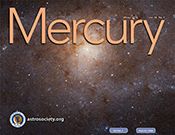Winter 2019 - Volume 48, Number 1

Table of Contents
[7] Space News
A rundown of some of the most exciting developments in space and time.
[29] Cosmic Views, Jason Major
OSIRIS-REx gets a close-up view of asteroid Bennu and China lands on the far side of the moon.
[31] Probing the Primordial, Tracy Staedter
When NASA’s New Horizons flew by Pluto in 2015, it was only the beginning of a Kuiper belt odyssey.
[36] General Relativity Falls Down, Matthew R. Francis
A bizarre triple star system, comprised of a pulsar and two white dwarfs, provides the best test yet for the universality of gravity.
Departments
[3] Perspectives, Ian O'Neill
Lucky Peanuts
[4] First Word, Linda Shore
Honoring the “Mother of Hubble”
[6] ASP News
ASP 2019 Award Nominations Now Open
[13] Annals of Astronomy, Clifford J. Cunningham
The Controversial Comet of 1264
[15] Astronomer’s Notebook, Jennifer Birriel
Turning the Moon into a Particle Spectrometer
[17] Armchair Astrophysics, Christopher Wanjek
Holy Cow! What Was That?
[19] Education Matters, Brian Kruse
Windows, Mirrors, and Sliding Doors to the Universe
[22] A Little Learning, C. Renee James
Left to Their Own Devices
[26] Guest Observer, William Romanishin
A Fortuitous Sighting of an Earthlit Moonrise
Bennu’s Boulders (Cosmic Views)
By Jason Major
Rocks and boulders of all sizes cast long shadows during a “sunrise” on the asteroid Bennu in this image, captured by NASA’s Origins, Spectral Interpretation, Resource Identification, Security-Regolith Explorer—a.k.a. OSIRIS-REx—spacecraft on Jan. 17, 2019.
Probing the Primordial (Feature)
By Tracy Staedter
Just 33 minutes after the ball dropped in Times Square on January 1, 2019, people had another reason to celebrate. NASA’s New Horizons spacecraft flew as close as it ever would to one of the oldest and most distant objects humans have aspired to encounter: 2014 MU69.
General Relativity Falls Down, Again (Feature)
By Matthew R. Francis
About four thousand light-years from Earth, a strange gravitational dance is taking place. The dancers are two white dwarfs in orbit around a pulsar that spins 366 times per second. The specifics of this bizarre trio, however, make it one of the best laboratories for testing a central tenet of Einstein’s theory of general relativity: the universality of free fall.
